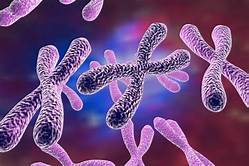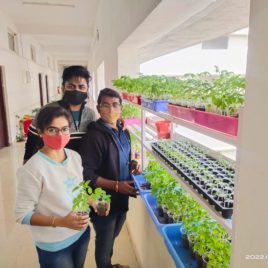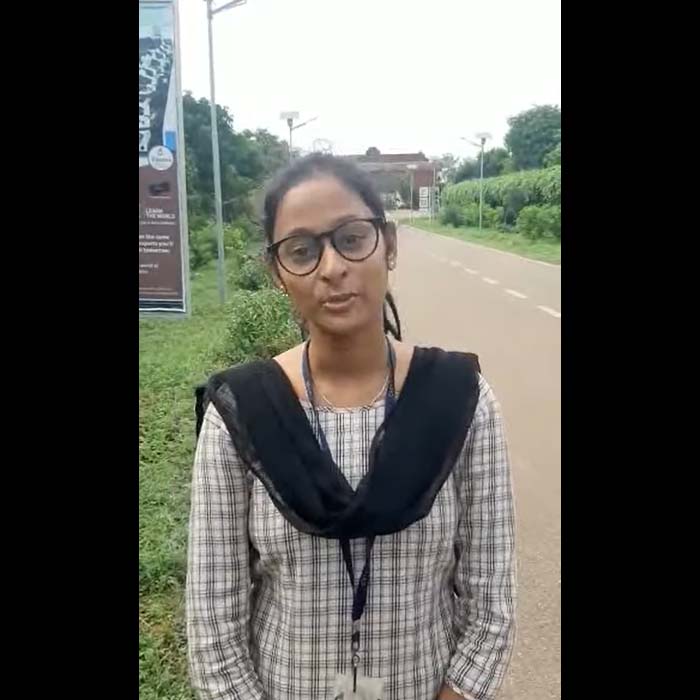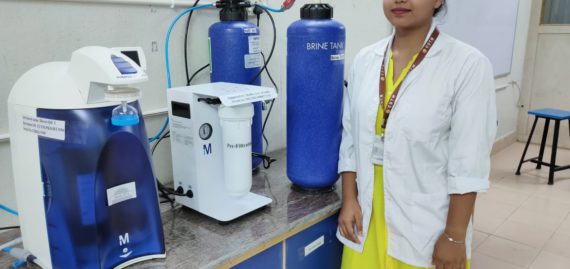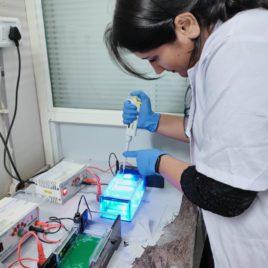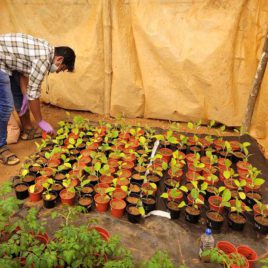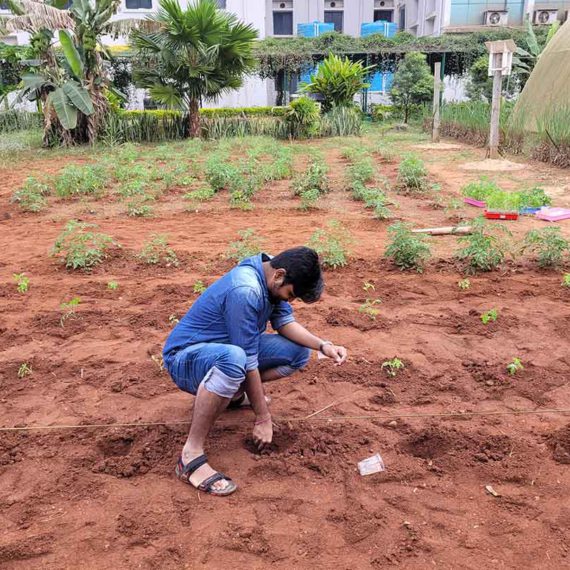Genetic Engineering and Genomics is considered to be one of the advanced and cutting-edge researches in the field of biological sciences and thus the curriculum structure of this domain is largely meant to enrich the scientific temper among the young minds. Advanced topics including Computational Biology, Genetic Engineering and its applications, Genetics and Genomics have been included so as to disseminate the technical know-how to learners which would be extremely significant for their future endeavours. The course structure of Genetic Engineering and Genomics domain is largely targeted for undergraduate and postgraduate students.
Domain Track: Genetic Engineering and Genomics
Course Attendees
Still no participant
Course Reviews
Still no reviews
Track Total Credit (T-P-P): 9-9-11
Course Division (list of all divisions) :
Track Courses (3-6-0)
- Computational Biology 1-2-0
- Genetic Engineering and its applications 1-2-0
- Genetics and Genomics 1-2-0
Practice Courses (0-9-0)
- Molecular Genomics 0-3-0
- Plant Tissue Culture Technologies 0-3-0
- Techniques in Molecular Biology 0-3-0
AELP Project (0-0-11)
- Exploration of available various sequences from different crops.
- In vitro micro-propagation of banana and hardening.
- Commercial production of horticultural crops.
- Standardization of protocol for in vitro micro-propagation of horticulture crops.
- DNA isolation, amplification and gel electrophoresis of plant sample.
- Phenotyping and genotyping of rice varieties for abiotic stress tolerance.
- Genome editing techniques towards crop improvement.
- The RNA secondary structure variation in viruses and the possible implication in pathogenicity
- Understanding RNA Protein interactions in viruses
Domain Track Objectives:
The primary objectives of this domain are to enable and familiarize the students with the basic concepts of Bioinformatics and its significance in biological data analysis, recent tools used for genome analysis and their applications, plant tissue culture and most importantly to provide hands-on training on basic molecular biology techniques.
To impart basic knowledge of bioinformatics in in silico and genomics to the students studying agriculture.
Domain Track Learning Outcome:
- To get introduced to the basic concepts of Bioinformatics and its significance in Biological data analysis.
- To familiarize the students with recent tools used for genome analysis and their applications.
- To provide and train the students for commercial plant tissue culture raised plant production and meet the industrial requirement.
- To provide hands on training on basic molecular biology techniques.
- Understand the properties of DNA, RNA, and proteins, the relationships among these molecules, and some biological questions that have puzzled researchers.
- Read and understand solutions to computational problems, which will be formalized as a series of tasks.
- Understand and analyze general approaches for solving computational problems and learners will be able to apply these approaches to new problems they encounter.
- Manipulate specific genes to produce desired traits, and how to address current problems faced by humanity.
- Understand and analysethe methods to modify genes to create Genetically Modified Organisms (GMOs) and example applications of bacteria, plant and animal GMOs.
Career Scope:
To build a career in the field of Genetic Engineering and Genomics is extremely fascinating but challenging as it requires expertise in most of the advanced biological concepts. Multifaceted opportunities from various sectors including Government, academia, industry and health care can be availed.
- After the completion of the course, learners will be able to implement their technical (practical) experiences in their future research by getting enrolled to Ph.D. programs. They will also have better opportunities to serve as project associates in funded projects.
- Data scientists, genomics researcher, life scientists, genetic counsellor are some of the relevant positions offered to skilled personals in the industrial sector.
- Graduates can also build up their own start-ups.
Domain Syllabus:
Computational Biology
Theory:
- Biological databases: Overview of biological databases, nucleic acid & protein databases, primary, secondary, functional, composite, structural classification of databases. Alignment using BLAST and CLUSTAL W.<
- li>
- RNA and DNA folding: Introduction to RNA and DNA folding, Softwares and webservers used for DNA or RNA folding: Mfold, RNAfold, RNA structure
- Insilico Drug Design: Basic Concepts, importance and application. Molecular Docking
- Python Tools for Computational Molecular Biology: Introduction to Biopython
- Practice in Project Mode: NCBI GenBank resources - Overview, Access, Data Usage, Confidentiality, International Nucleotide Sequence Database Collaboration, Data Type, European Nucleotide Archive - sequence assembly information and functional annotation, DNA Data Bank of Japan (DDBJ). Kyoto Encyclopedia of Genes and Genomes (KEGG), Retrieval of sequence/structure from databases, Visualization of structures, Docking of ligand receptors, BLAST exercises, Molecular models, drug design, Python based computational biology - Biopython.
Suggested Readings:
- Attwood TK & Parry-Smith DJ. 2003. Introduction to Bioinformatics. Pearson Education.
- Rastogi SC, Mendiratta N & Rastogi P. 2004. Bioinformatics: Concepts, Skills and Applications. CBS.
2. Genetic Engineering and its applications
Theory:
- Plant Tissue culture: Cell culture media and sterilization techniques, Callus culture, nodal and tip culture, Protoplast and Embryo culture, Embryo culture and embryo rescue, protoplast isolation, culture and plant regeneration Somatic embryogenesis, Somaclonal variation and crop improvement, Germplasm conservation.
- Recombinant DNA technology: Introduction to genetic engineering, restriction endonucleases and methylases; DNA ligase, T4 DNA polymerase, polynucleotide kinase, alkaline phosphatase. Gene cloning vectors: Plasmids; Bacteriophages; phagemids; Lambda vectors; Cosmids; Artificial chromosome vectors (YACs; BACs).Construction of recombinant DNA and expression cassettes, Transformation (mobilization of vectors into competent bacteria), selection and analysis of recombinant clones, Isolation of mRNA and total RNA; reverse transcriptase and cDNA synthesis; Genomic DNA & plasmid DNA isolation and purification, genomic DNA and cDNA libraries, screening of libraries.
- Gene transfer in Plants: Vector mediated Gene transfer, Molecular basis of crown gall and hairy root diseases, features of Ti and Ri plasmids, mechanism of T-DNA transfer, role of virulence genes, vectors based on PTi & PRi, binary and co-integrate vectors, physical and chemical methods of gene transfer. Introduction to gene editing, ZFNs & TALENs, CRISPR/Cas System, Case studies of gene editing for crop improvement.
- Practice in Project Mode: DNA isolation and purification, Callus induction, Agrobacterium mediated gene transfer in plants, vector construction, cloning and transformation.
Suggested Readings:
- Glick, B. R. and Pasternak (2003). Molecular Biotechnology: Principles and Applications of Recombinant DNA. ASM Press, Washington, D. C., USA.
- Kyte, L. and Kleyn, J. (1996). Plants from Test Tube to: an Introduction to Micro propagation, 3rd Ed. Timber press, Port land, USA.
- Reference Book
Pollard, W. J. and Walker (1990).Plant Cell and Tissue Culture Vol VI. Humana press Clifton, USA.
3. Genetics and Genomics
Theory:
- Basic of genetics: Mendel’s Laws, concept of dominance, segregation, independent assortment; Chromosome theory of inheritance.
- Genome Mapping and Sequencing: Genetic and physical mapping, Markers for genetic mapping, Human Genome Project, Genome sequencing projects for microbes, Genome sequencing projects for plants and animals, Accessing and retrieving genome project information from the web. Genome sequencing: assembly, alignment and annotation. DNA sequencing strategies, Next generation sequencing strategies.
- Functional genomics and proteomics: Introduction to genomics, transcriptome analysis for identification and functional annotation of gene, forward and reverse genetic approaches. Introduction to proteomics, proteomics technologies: 2D-PAGE, isoelectric focusing, Mass spectrometry.
- Practice in Project mode: Demonstration of web tools for genome analysis. Effect of abiotic stress on field crops (Phenotyping), Effect of growth regulators on field crops (Phenotyping), Salinity/Cold/High Temperature stress tolerance genes and their responsiveness (Genotyping), Molecular markers (RAPD, SSR, AFLP etc) and their analysis.
Suggested Readings:
- Practical Applications of Plant Molecular Biology By Robert J. Henry.
- Biochemistry and Molecular Biology of Plants edited by Bob B. Buchanan, Wilhelm Gruissem, Russell L. Jones.
Session Plan:
1. Computational Biology
Session 1.1
Theory:
- Computational Biology: Basic Concepts, importance and application
Practice:
- Demonstration and usage of web resources: EMBL, GenBank, ENTREZ
- Video Link ...

Session 1.2
Theory:
- Biological Databases, Classification and different types of Biological Database
Practice:
- Demonstration and usage of protein databases: PDB, PIR, SwissProt, tREMBL
- Video Link ...

Session 1.3
Theory:
-
- DNA and Protein sequence analysis, Pairwise and multiple sequence alignment
Practice:
-
-
- Sequence similarity serach using BLAST
- Video Link ...

-
Session 1.4
Theory:
-
-
- Protein structural analysis, protein structure modeling and prediction
-
Practice:
-
-
- Multiple sequence alignment using ClustalW
- Video Link ...

-
Session 1.5
Theory:
-
-
- Molecular evolution, Phylogenetics analysis, analysis packages dealing with molecular evolution and phylogenesis
-
Practice:
-
-
- Phylogenetic analysis through Neighbor joining method using MEGA tool
- Video Link 1...

- Video Link 2...

-
Session 1.6
Theory:
-
-
- In silico Drug Design: Basic Concepts, importance and application
-
Practice:
-
-
- Molecular docking
- Molecular docking...

-
Session 1.7
Theory:
-
-
- Methods of in silico Drug Design: structure and ligand based drug design approach
-
Practice:
-
-
- Structure based drug design
- Structure based drug design Material...

-
Session 1.8
Theory:
-
-
- Biopython: Introduction, important features and application of biopython in computational biology
-
Practice:
-
-
- Demonstration of Biopython
- Video Link ...

-
Session 1.9
Theory:
-
-
- Create a simple sequence in Biopython for DNA, RNA and Protein Alphabets
-
Practice:
Session 1.10
Theory:
-
-
- Sequence Alignment Tools in Biopython
-
Practice:
-
-
- Sequence alignment using Biopython
- Video Link ...

-
2. Genetic Engineering and its applications (1+2)
Session 2.1
Theory:
-
-
- Plasmids, vectors and enzymes used in genetic engineering
-
Practice:
-
-
- Restriction digestion
- Video Link 1...

- Video Link 2...

-
Session 2.2
Theory:
-
-
- Genomic DNA and plasmid DNA isolation and purification
-
Practice:
-
-
- Isolation and purification of Plant DNA
- Video Link 1...

- Video Link 2...

-
Session 2.3
Theory:
-
-
- Vecor construction, transformation and selection of transformants
-
Practice:
-
-
- Plasmid DNA isolation and purification
- Video Link ...

-
Session 2.4
Theory:
-
-
- Genomic library and cDNA library, screening of libraries.
-
Practice:
-
-
- Quantitative and qualitative estimation of DNA/RNA
- Video Link ...

-
Session 2.5
Theory:
-
-
- Plant Transformation-Ti and Ri plasmids
-
Practice:
-
-
- Elution of specific DNA fragment from PCR products
- Video Link 1...

- Video Link 2...

-
Session 2.6
Theory:
-
-
- Molecular basis of crown gall disease and hairy root disease
-
Practice:
- Cloning of DNA fragments into suitable vectors
- Video Link ...

Session 2.7
Theory:
- Binary and Co-integrative vectors, Mechanism of DNA transfer
Practice:
- Transformation of recombinant vectors into E. coli cells
- Video Link 1...

- Video Link 2...

Session 2.8
Theory:
- Physical and Chemical methods of Gene transfer
Practice:
- Selection and screening of positive transformants using colony PCR
- Video Link 1...

- Video Link 2...

- Video Link 3...

Session 2.9
Theory:
- Introduction to gene editing, ZFNs and TALENs
Practice:
- Demonstration of Agrobacterium infection in tobacco plants
- Video Link 1...

- Video Link 2...

- Video Link 3...

Session 2.10
Theory:
- CRISPR/Cas genome editing, case studies of editing tools in crop improvement
Practice:
- Designing of sgRNAs using the RGEN tool
- Video Link 1...

- Video Link 2...

3. Genetics and Genomics
Session 3.1
Theory:
- Mendelian Genetics
Practice:
- Karyotyping using photographs
Session 3.2
Theory:
- Effect of abiotic stresses on field crops
Practice:
- Effect of abiotic stress on field crops (Phenotyping)
- Effect of abiotic stress on field crops Case Studies...

Session 3.3
Theory:
- Effect of biotic stress on among field crops
Practice:
- Effect of biotic stress on field crops (Phenotyping)
Session 3.4
Theory:
- Molecular analysis of biotic stress tolerance among field crops
Practice:
- Molecular markers and their analysis (Genotyping)
- Molecular markers and their analysis GPL...

Session 3.5
Theory:
- Introduction to Genomics
Practice:
- Demonstration of the working conditions of PCR
- Video Link 1...

- Video Link 2...

Session 3.6
Theory:
- DNA Sequencing, Genome sequencing projects for microbes, plants and animals
Practice:
- Demonstration of the working conditions of qRTPCR
- Video Link 1...

- Video Link 2...

Session 3.7
Theory:
- Accessing and retrieving genome project information in in silico
Practice:
- Retrieval of data from the genome sequences databases
- Video Link 1...

- Video Link 2...

Session 3.8
Theory:
- Proteomics technologies: Protein Extraction, 2D-PAGE, isoelectric focusing, Mass spectrometry
Practice:
- RNA isolation from plants
- RNA isolation from plants GPL...

- Video Link ...

Session 3.9
Theory:
- Transcriptome analysis for identification and functional annotation of gene
Practice:
- Protein extraction from plants
- Protein extraction from plants GPL Protocol...

- Video Link ...

Session 3.10
Theory:
- Gene function- forward and reverse genetics
Practice:
- Synthesis of cDNA from supplied RNA using reverse transcription approach
- Video Link ...

Practice Courses
4. Plant Tissue Culture Techniques (0-3-0) Practice-Session Plan
Practice 1
- Micropropagation in plants
- Video Link ...

Practice 2
- Anther, Pollen and ovule culture, Embryo culture
Practice 3
- Somatic embryogenesis – Induction and Development method
- Video Link ...

Practice 4
- Protoplast isolation – Enzymatic and Mechanical method
- Video Link ...

Practice 5
- Vector-mediated gene transfer by using Agrobacterium tumefaciens
- Video Link 1...

- Video Link 2...

5. Techniques in Molecular Biology (0-3-0) Practice-Session Plan
Practice 1
- Isolation and purification of DNA from plant material.
- Video Link ...

Practice 2
- DNA amplification by using PCR and optimization of factors affecting PCR
- Video Link 1...

- Video Link 2...

Practice 3
- Gel electrophoresis- agarose and PAGE (nucleic acids and proteins).
- Video Link 1...

- Video Link 2...

- Video Link 3...

Practice 4
- Restriction digestion of plasmid and phage DNA
- Video Link 1...

- Video Link 2...

- Video Link 3...

Practice 5
- Gene cloning – Recombinant DNA construction, transformation and selection of transformants
- Video Link 1...

- Video Link 2...

6. Molecular genomics (0-3-0) Practice-Session Plan
Practice 1
- Demonstration of genome browsers- ENSEMBL, VISTA and UCSC Genome Browser
Practice 2
- Identification of gene characteristics using ExPaSy tools
Practice 3
- Phylogenetic analysis using genomic tools
Practice 4
- Demonstration of genome assembly & alignment using web tools (for ex. Splign etc.)
Practice 5
- Demonstration of genome comparison using MOAV tool or other web tools
List of Projects to be done under the Domain
- Exploration of available various sequences from different crops.
- In vitro micro-propagation of banana and hardening.
- Commercial production of horticultural crops.
- Standardization of protocol for in vitro micro-propagation of horticulture crops.
- DNA isolation, amplification and gel electrophoresis of plant sample.
- Phenotyping and genotyping of rice varieties for abiotic stress tolerance.
- Genome editing techniques towards crop improvement.
- NGS data analysis and data representation using open source tools or JMP software.
- Understanding RNA-protein interactions in viruses
Media

Our Main Teachers
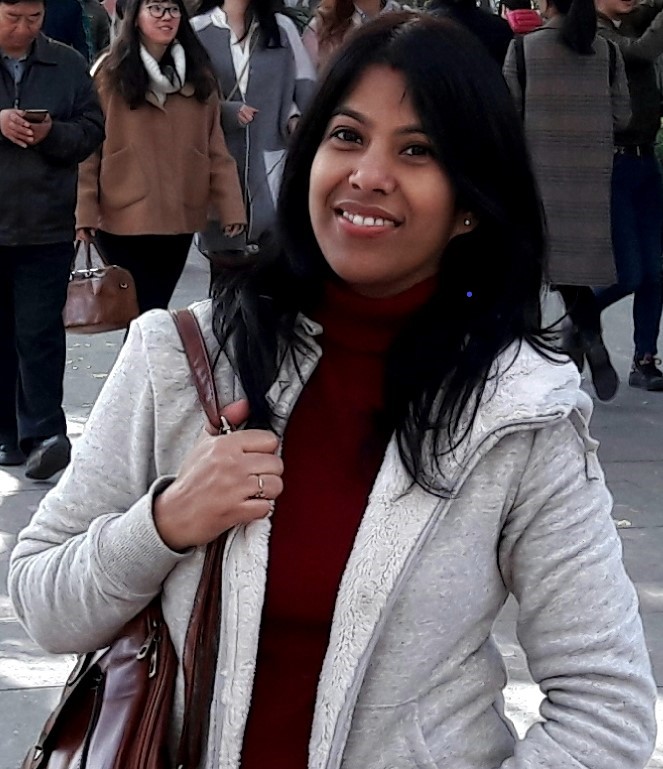
Dr Rukmini Mishra is presently working as an Assistant Professor (Botany), School of Applied Science, Centurion University of Technology and Management. She has a PhD in Agricultural Biotechnology from ICAR-National Rice Research Institute, India. After PhD, she received the prestigious Young Scientist Award from the Dept. of Science & Technology, SERB, Govt. of India to […]
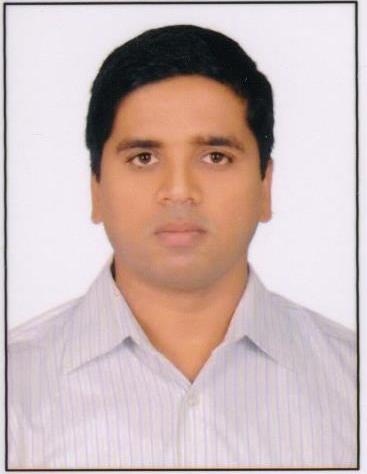
Dr. Ranjan Kumar Sahoo has 12 years teaching and 10 years research experience in the field of biotechnology. He is currently working as Associate Professor and Head in Department of Biotechnology, Centurion University of Technology and Management, Bhubaneswar, Odisha, India. He has published 4 text books, more than 60 research publications in reputed Indian and […]

Dr. Satyabrata Nanda has a Ph.D. in Biotechnology with a specialization in Plant Protection from Siksha O Anusandhan University, Odisha. His education includes B-Tech, M-Tech, and Ph.D. in Biotechnology. After his Ph.D., he received the Overseas Postdoctoral Fellowship from the Chinese Academy of Agricultural Sciences (CAAS) to carry out further research at China National Rice […]

Dr. Sutar Suhas Bharat is presently working as an Assistant Professor at Department of Botany,SoAS, CUTM, Odisha. He has a Ph.D. in Biochemistry at Institute of Crop Sciences, Chinese Academy of Agricultural Sciences, Beijing, China. He haspursued his MSc. (Biotechnology) from TNAU, Coimbatore, TamilNadu, India and completed BSc. in agricultural biotechnology from Vasantrao Nai Marathwada […]

